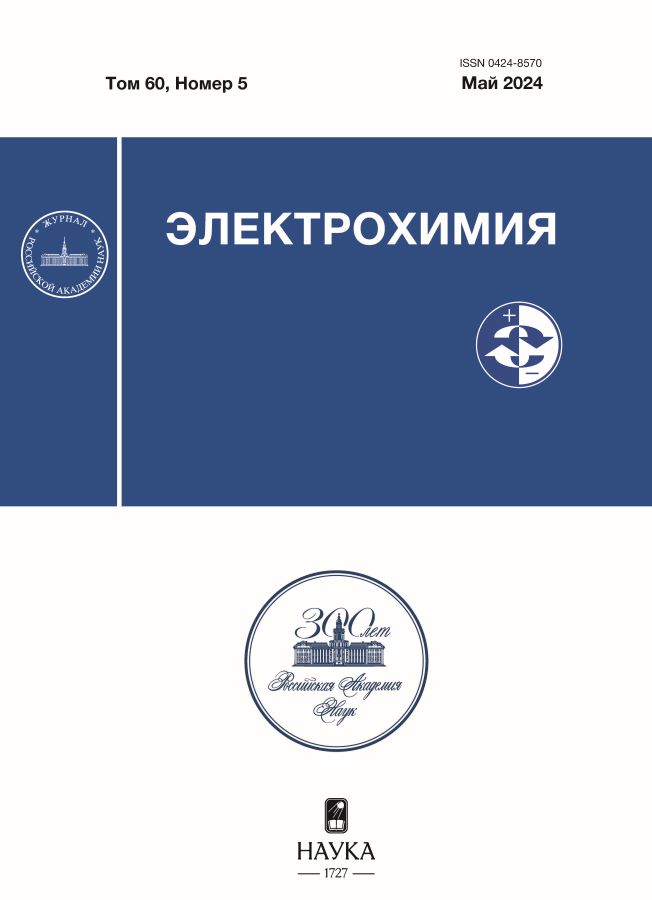The effect of decalin and perfluorodecalin on Dendrite formation at metal lithium anodes During their operation
- Authors: Alpatov S.S.1, Vasiliev F.A.1, Semenikhin O.A.1
-
Affiliations:
- M.V. Lomonosov Moscow State University
- Issue: Vol 60, No 5 (2024)
- Pages: 373-384
- Section: Articles
- URL: https://medjrf.com/0424-8570/article/view/671398
- DOI: https://doi.org/10.31857/S0424857024050057
- EDN: https://elibrary.ru/qnjlzm
- ID: 671398
Cite item
Abstract
In this work, we studied the effect of additions of decahydronaphthalene (decalin) and its derivative, perfluorodecalin (octadecafluorodecalin), on the deposition and dissolution of lithium metal, including dendrite formation, at the anodes of secondary lithium power sources in an electrolyte based on lithium hexafluorophosphate and a mixture of ethylene carbonate (EC) and diethyl carbonate (DEC). The study was carried out using the methods of current transients and electrochemical impedance. The results showed that, in contrast to traditional cationic surfactants cetyltrimethylammonium bromide and hexadecylpyridinium bromide, which we studied earlier, decalin and perfluorodecalin demonstrate specific interaction with the surface of the lithium electrode. Moreover, the interaction with decalin is so strong that it actually blocks the processes of both deposition and anodic dissolution of lithium at the surface of the lithium electrode. The interaction of perfluorodecalin with the lithium surface turned out to be weaker. As a result, perfluorodecalin does not interfere with the cycling of the metal lithium anode, but at the same time shows an inhibitory effect on the dendrite formation. In the electrolyte with the addition of perfluorodecalin, lithium anode was able to undergo more than 80 charge-discharge cycles with a Coulomb efficiency of 70–80%, while without the additive, the number of cycles was less than 40, and the Coulomb efficiency was 60% or lower.
Full Text
About the authors
S. S. Alpatov
M.V. Lomonosov Moscow State University
Email: osemenik@elch.chem.msu.ru
Department of Chemistry
Russian Federation, MoscowF. A. Vasiliev
M.V. Lomonosov Moscow State University
Email: osemenik@elch.chem.msu.ru
Department of Chemistry
Russian Federation, MoscowO. A. Semenikhin
M.V. Lomonosov Moscow State University
Author for correspondence.
Email: osemenik@elch.chem.msu.ru
Department of Chemistry
Russian Federation, MoscowReferences
- Алпатов, С. С., Васильев, Ф. А., Алешина, В. Х., Ваграмян, Т. А., Семенихин, О. А. Электроосаждение лития в присутствии поверхностно-активных веществ. Электрохимия. 2024. Т. 60. № 5. С. 349.
- Алпатов, С. С., Васильев, Ф. А., Алешина, В. Х., Ваграмян, Т. А., Семенихин, О. А. Анализ спектров электрохимического импеданса и строения твердоэлектролитной интерфазы на электроосажденном металлическом литии с использованием метода распределения времен релаксации. Электрохимия. 2024. Т. 60. № 5. С. 361.
- Chen, S.R., Dai, F., and Cai, M., Opportunities and Challenges of High-Energy Lithium Metal Batteries for Electric Vehicle Applications, ACS Energy Lett., 2020, vol. 5, p. 3140.
- Liu, D.H., Bai, Z.Y., Li, M., Yu, A.P., Luo, D., Liu, W.W., Yang, L., Lu, J., Amine, K., and Chen, Z.W., Developing high safety Li-metal anodes for future high-energy Li-metal batteries: strategies and perspectives, Chem. Soc. Rev., 2020, vol. 49, p. 5407.
- Qin, K., Holguin, K., Mohammadiroudbari, M., Huang, J., Kim, E. Y. S., Hall, R., and Luo, C., Strategies in structure and electrolyte design for high-performance lithium metal batteries, Adv. Funct. Mater., 2021, vol. 31, p. 2009694.
- Besenhard, J.O., Gürtler, J., Komenda, P., and Paxinos, A., Corrosion protection of secondary lithium electrodes in organic electrolytes, J. Power Sources, 1987, vol. 20, p. 253.
- von Aspern, N., Roeschenthaler, G.-V., Winter, M., and Cekic-Laskovic, I., Fluorine and Lithium: Ideal Partners for High-Performance Rechargeable Battery Electrolytes, Angew. Chem. Int. Ed., 2019, vol. 58, p. 16124.
- Xu, N., Shi, J., Liu, G., Yang, X., Zheng, J., Zhang, Z., and Yang, Y., Research progress of fluorine-containing electrolyte additives for lithium ion batteries, J. Power Sources Adv., 2021, vol. 7, p. 100043.
- Scharifker, B. and Hills, G., Theoretical and experimental studies of multiple nucleation, Electrochim. Acta, 1983, vol. 28, p. 879.
- Scharifker, B.R., Mostany, J., Palomar‐Pardavé, M., and González, I., On the theory of the potentiostatic current transient for diffusion‐controlled three‐dimensional electrocrystallization processes, J. Electrochem. Soc., 1999, vol. 146, p. 1005.
Supplementary files















